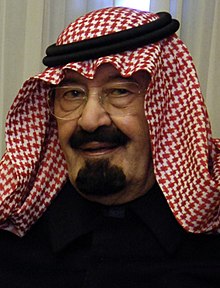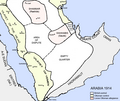The Saudi Arabia Portal – بوابة المملكة العربية السعودية
Saudi Arabia, officially the Kingdom of Saudi Arabia (KSA), is a country in West Asia and the Middle East. It covers the bulk of the Arabian Peninsula and has a land area of about 2150000 km2 (830000 sq mi), making it the fifth-largest country in Asia and the largest in the Middle East. It is bordered by the Red Sea to the west; Jordan, Iraq, and Kuwait to the north; the Persian Gulf, Qatar and the United Arab Emirates to the east; Oman to the southeast; and Yemen to the south. Bahrain is an island country off its east coast. The Gulf of Aqaba in the northwest separates Saudi Arabia from Egypt and Israel. Saudi Arabia is the only country with a coastline along both the Red Sea and the Persian Gulf, and most of its terrain consists of arid desert, lowland, steppe, and mountains. The capital and largest city is Riyadh; the kingdom also hosts Islam's two holiest cities of Mecca and Medina. (Full article...) Selected article -Abdullah bin Abdulaziz Al Saud (Arabic: عبد الله بن عبدالعزيز آل سعود ʿAbd Allāh ibn ʿAbd al ʿAzīz Āl Saʿūd, Najdi Arabic pronunciation: [ʢæbˈdɑɫ.ɫɐ ben ˈʢæbdæl ʢæˈziːz ʔæːl sæˈʢuːd]; 1 August 1924 – 23 January 2015) was King and Prime Minister of Saudi Arabia from 1 August 2005 until his death in 2015. Prior to his ascension, he was Crown Prince of Saudi Arabia since 13 June 1982. He was the tenth son of King Abdulaziz, the founder of Saudi Arabia. Abdullah was the son of King Abdulaziz and Fahda bint Asi Al Shuraim. His mother was a member of the Al Rashid dynasty, historical rivals of the Al Saud dynasty. Abdullah held important political posts throughout most of his adult life. In 1961 he became mayor of Mecca, his first public office. The following year, he was appointed commander of the Saudi Arabian National Guard, a post he was still holding when he became king. He also served as deputy defense minister and was named crown prince when his half-brother Fahd took the throne in 1982. After King Fahd suffered a serious stroke in 1995, Abdullah became the de facto ruler of Saudi Arabia until ascending the throne a decade later. (Full article...)Did you know (auto-generated)
NewsNo recent news Related portalsReligions in Saudi Arabia Arab states WikiProjectsThings you can do
This is a Good article, an article that meets a core set of high editorial standards.
 The McMahon–Hussein Correspondence is a series of letters that were exchanged during World War I in which the Government of the United Kingdom agreed to recognize Arab independence in a large region after the war in exchange for the Sharif of Mecca launching the Arab Revolt against the Ottoman Empire. The correspondence had a significant influence on Middle Eastern history during and after the war; a dispute over Palestine continued thereafter. The correspondence is composed of ten letters that were exchanged from July 1915 to March 1916 between Hussein bin Ali, Sharif of Mecca and Lieutenant Colonel Sir Henry McMahon, British High Commissioner to Egypt. Whilst there was some military value in the Arab manpower and local knowledge alongside the British Army, the primary reason for the arrangement was to counteract the Ottoman declaration of jihad ("holy war") against the Allies, and to maintain the support of the 70 million Muslims in British India (particularly those in the Indian Army that had been deployed in all major theatres of the wider war). The area of Arab independence was defined to be "in the limits and boundaries proposed by the Sherif of Mecca" with the exception of "portions of Syria" lying to the west of "the districts of Damascus, Homs, Hama and Aleppo"; conflicting interpretations of this description were to cause great controversy in subsequent years. One particular dispute, which continues to the present, is the extent of the coastal exclusion. (Full article...)Selected pictureMore did you know
General imagesThe following are images from various Saudi Arabia-related articles on Wikipedia.
Featured contentFeatured articlesGood articles
Associated WikimediaThe following Wikimedia Foundation sister projects provide more on this subject:
Sources
Discover Wikipedia using portals | ||||







![Image 3A view of Jabal Sawda, a peak located in Saudi Arabia, with an elevation of around 3,000 metres (9,843 ft).[1]](http://upload.wikimedia.org/wikipedia/commons/thumb/5/59/Al_Sawda_peak.jpg/120px-Al_Sawda_peak.jpg)




















































